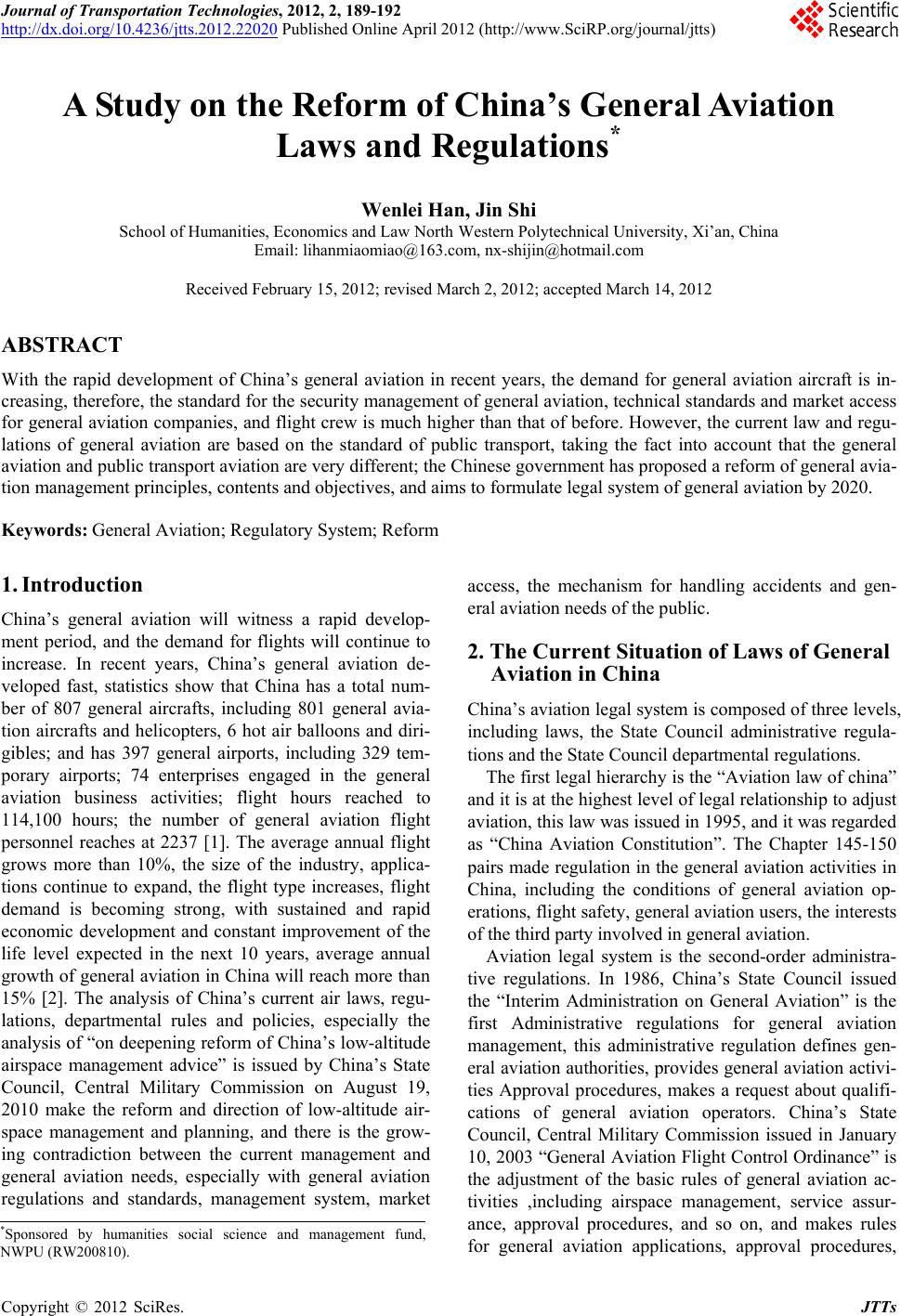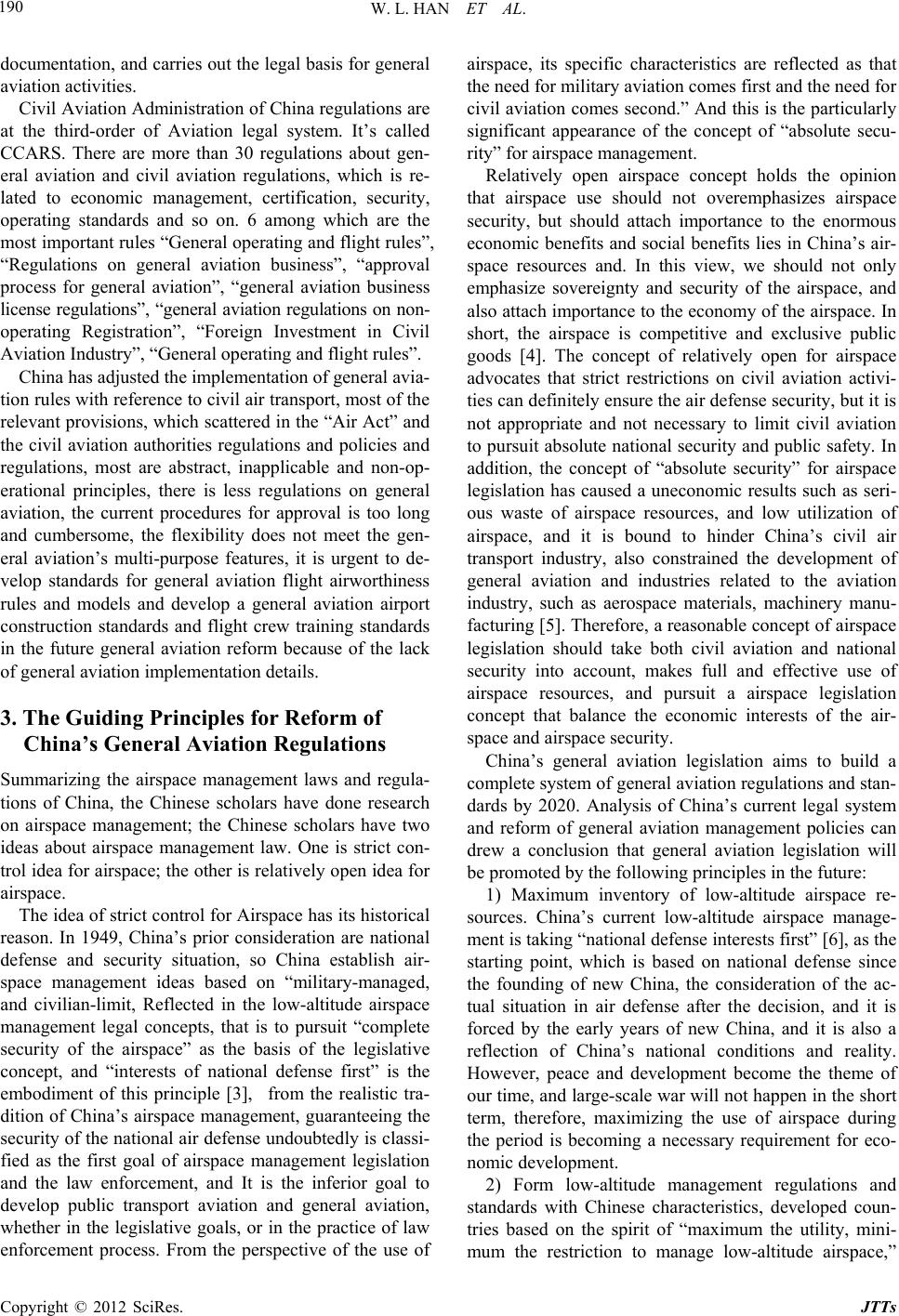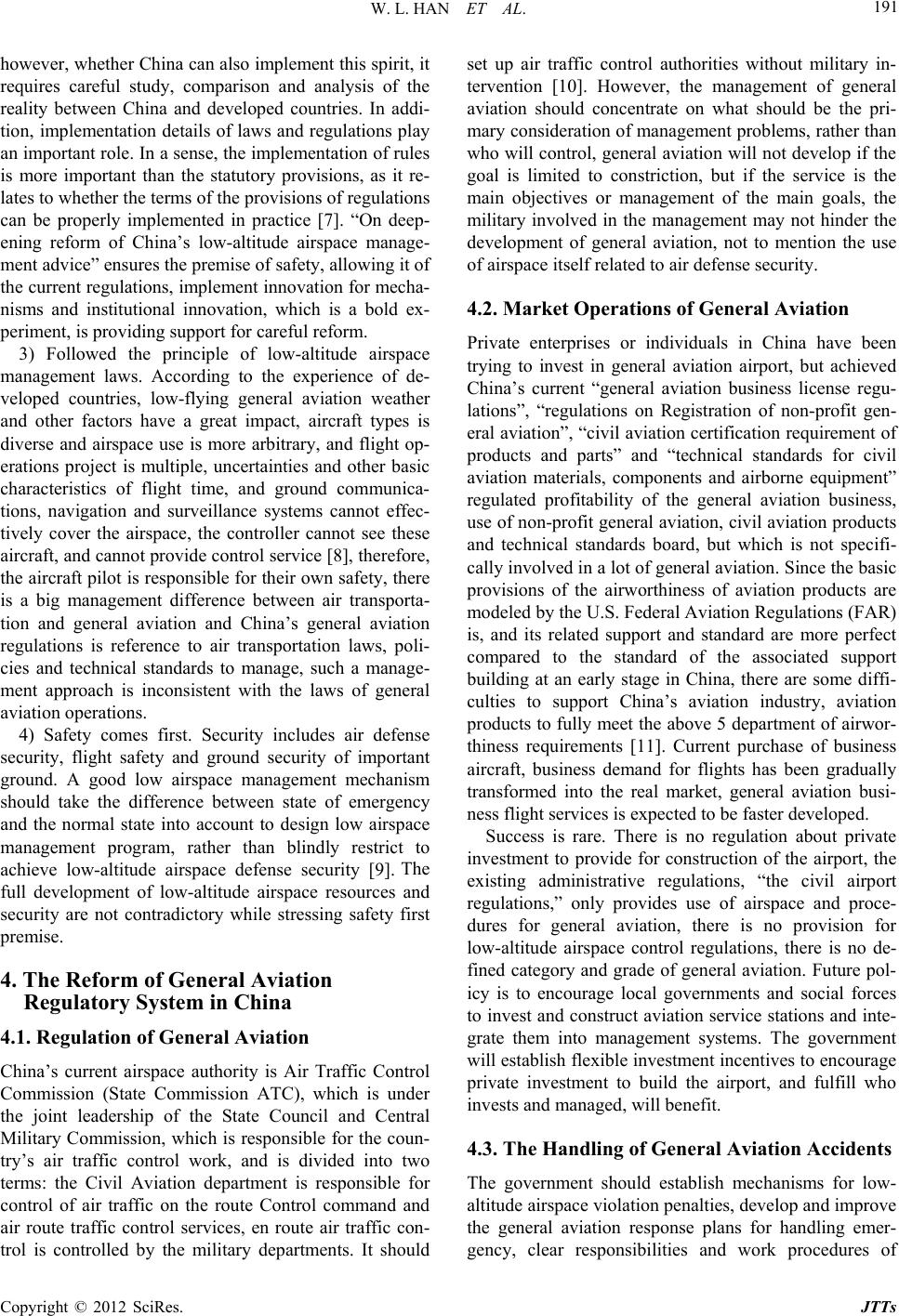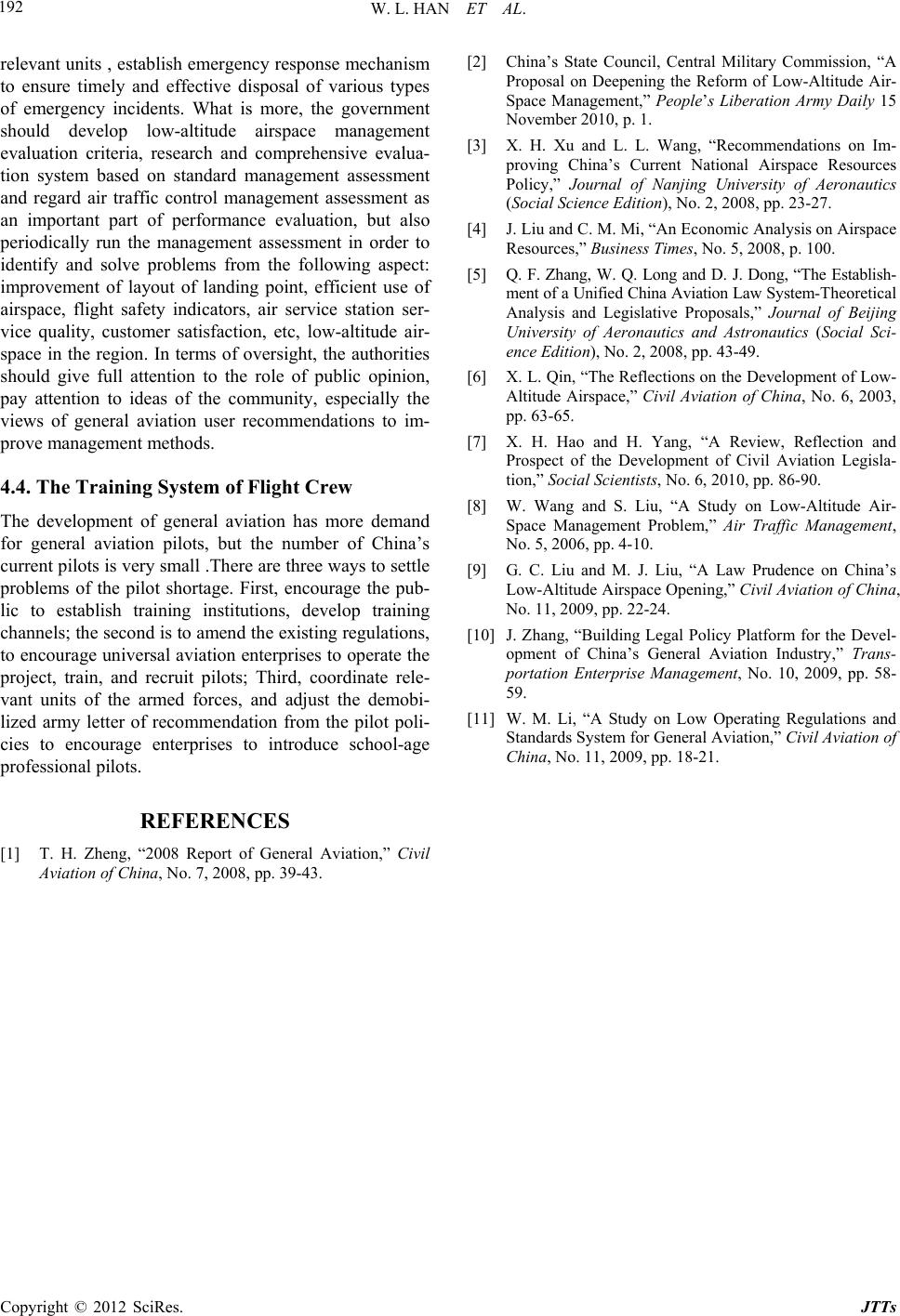Paper Menu >>
Journal Menu >>
 Journal of Transportation Technologies, 2012, 2, 189-192 http://dx.doi.org/10.4236/jtts.2012.22020 Published Online April 2012 (http://www.SciRP.org/journal/jtts) A Study on the Reform of China’s General Aviation Laws and Regulations* Wenlei Han, Jin Shi School of Humanities, Economics and Law North Western Polytechnical University, Xi ’a n, China Email: lihanmiaomiao@163.com, nx-shijin@hotmail.com Received February 15, 2012; revised March 2, 2012; accepted March 14, 2012 ABSTRACT With the rapid development of China’s general aviation in recent years, the demand for general aviation aircraft is in- creasing, therefore, the standard for the security management of general aviation, technical standards and market access for general aviation companies, and flight crew is much higher than that of before. However, the current law and regu- lations of general aviation are based on the standard of public transport, taking the fact into account that the general aviation and public transport aviation are very different; the Chinese government has proposed a reform of general avia- tion management principles, contents and objectives, and aims to formulate legal system of general aviation by 2020. Keywords: General Aviation; Regulatory System; Reform 1. Introduction China’s general aviation will witness a rapid develop- ment period, and the demand for flights will continue to increase. In recent years, China’s general aviation de- veloped fast, statistics show that China has a total num- ber of 807 general aircrafts, including 801 general avia- tion aircrafts and helicopters, 6 hot air balloons and diri- gibles; and has 397 general airports, including 329 tem- porary airports; 74 enterprises engaged in the general aviation business activities; flight hours reached to 114,100 hours; the number of general aviation flight personnel reaches at 2237 [1]. The average annual flight grows more than 10%, the size of the industry, applica- tions continue to expand, the flight type increases, flight demand is becoming strong, with sustained and rapid economic development and constant improvement of the life level expected in the next 10 years, average annual growth of general aviation in China will reach more than 15% [2]. The analysis of China’s current air laws, regu- lations, departmental rules and policies, especially the analysis of “on deepening reform of China’s low-altitude airspace management advice” is issued by China’s State Council, Central Military Commission on August 19, 2010 make the reform and direction of low-altitude air- space management and planning, and there is the grow- ing contradiction between the current management and general aviation needs, especially with general aviation regulations and standards, management system, market access, the mechanism for handling accidents and gen- eral aviation needs of the public. 2. The Current Situation of Laws of General Aviation in China China’s aviation legal system is composed of three levels, including laws, the State Council administrative regula- tions and the State Council departmental regulations. The first legal hierarchy is the “Aviation law of ch ina” and it is at the highest level of legal relationship to ad just aviation, this law was issued in 1995, and it was regarded as “China Aviation Constitution”. The Chapter 145-150 pairs made regulation in the general aviation activities in China, including the conditions of general aviation op- erations, flight safety, general aviatio n u sers, th e in terests of the third party involved in general aviation. Aviation legal system is the second-order administra- tive regulations. In 1986, China’s State Council issued the “Interim Administration on General Aviation” is the first Administrative regulations for general aviation management, this administrative regulation defines gen- eral aviation author ities, provides general aviation activi- ties Approval procedures, makes a request about qualifi- cations of general aviation operators. China’s State Council, Central Military Commission issued in January 10, 2003 “General Aviation Flight Control Ordinance” is the adjustment of the basic rules of general aviation ac- tivities ,including airspace management, service assur- ance, approval procedures, and so on, and makes rules for general aviation applications, approval procedures, *Sponsored by humanities social science and management fund, N WPU (RW200810). C opyright © 2012 SciRes. JTTs  W. L. HAN ET AL. 190 documentation, and carries out the legal basis for general aviation activities. Civil Aviation Administration of China regulations are at the third-order of Aviation legal system. It’s called CCARS. There are more than 30 regulations about gen- eral aviation and civil aviation regulations, which is re- lated to economic management, certification, security, operating standards and so on. 6 among which are the most important rules “General operating and flight rules”, “Regulations on general aviation business”, “approval process for general aviation”, “general aviation business license regulations”, “general aviation regulations on non- operating Registration”, “Foreign Investment in Civil Aviation Industry”, “General operating and fligh t rules”. China has adjusted the implementation of general avia- tion rules with reference to civil air transport, most of the relevant provisions, which scattered in the “Air Act” and the civil aviation authorities regulations and policies and regulations, most are abstract, inapplicable and non-op- erational principles, there is less regulations on general aviation, the current procedures for approval is too long and cumbersome, the flexibility does not meet the gen- eral aviation’s multi-purpose features, it is urgent to de- velop standards for general aviation flight airworthiness rules and models and develop a general aviation airport construction standards and flight crew training standards in the future general aviation reform because of the lack of general aviation implementation details. 3. The Guiding Principles for Reform of China’s General Aviation Regulations Summarizing the airspace management laws and regula- tions of China, the Chinese scholars have done research on airspace management; the Chinese scholars have two ideas about airspace management law. One is strict con- trol idea for airspace; the other is relatively open idea for airspace. The idea of strict control for Airspace has its historical reason. In 1949, China’s prior consideration are national defense and security situation, so China establish air- space management ideas based on “military-managed, and civilian-limit, Reflected in the low-altitude airspace management legal concepts, that is to pursuit “complete security of the airspace” as the basis of the legislative concept, and “interests of national defense first” is the embodiment of this principle [3], from the realistic tra- dition of China’s airspace management, guaranteeing the security of the national air defense undoubtedly is classi- fied as the first goal of airspace management legislation and the law enforcement, and It is the inferior goal to develop public transport aviation and general aviation, whether in the legislative goals, or in the practice of law enforcement process. From the perspective of the use of airspace, its specific characteristics are reflected as that the need for military aviation comes first and the need for civil aviation co mes second.” And this is the particularly significant appearance of the concept of “absolute secu- rity” for airspace management. Relatively open airspace concept holds the opinion that airspace use should not overemphasizes airspace security, but should attach importance to the enormous economic benefits and social benefits lies in China’s air- space resources and. In this view, we should not only emphasize sovereignty and security of the airspace, and also attach importance to the economy of the airspace. In short, the airspace is competitive and exclusive public goods [4]. The concept of relatively open for airspace advocates that strict restrictions on civil aviation activi- ties can definitely ensure the air defense security, but it is not appropriate and not necessary to limit civil aviation to pursuit absolu te national security and public safety. In addition, the concept of “absolute security” for airspace legislation has caused a uneconomic results such as seri- ous waste of airspace resources, and low utilization of airspace, and it is bound to hinder China’s civil air transport industry, also constrained the development of general aviation and industries related to the aviation industry, such as aerospace materials, machinery manu- facturing [5]. Therefore, a reasonable concept of airspace legislation should take both civil aviation and national security into account, makes full and effective use of airspace resources, and pursuit a airspace legislation concept that balance the economic interests of the air- space and airspace security. China’s general aviation legislation aims to build a complete system of general aviation regu lations an d stan- dards by 2020. Analysis of China’s current legal system and reform of general aviation management policies can drew a conclusion that general aviation legislation will be promoted by the following principles in the future: 1) Maximum inventory of low-altitude airspace re- sources. China’s current low-altitude airspace manage- ment is taking “national defense interests first” [6], as the starting point, which is based on national defense since the founding of new China, the consideration of the ac- tual situation in air defense after the decision, and it is forced by the early years of new China, and it is also a reflection of China’s national conditions and reality. However, peace and development become the theme of our time, and large-scale war will not happen in the short term, therefore, maximizing the use of airspace during the period is becoming a necessary requirement for eco- nomic development. 2) Form low-altitude management regulations and standards with Chinese characteristics, developed coun- tries based on the spirit of “maximum the utility, mini- mum the restriction to manage low-altitude airspace,” Copyright © 2012 SciRes. JTTs  W. L. HAN ET AL. 191 however, whether China can also implement this spirit, it requires careful study, comparison and analysis of the reality between China and developed countries. In addi- tion, implementation details of laws and regulations play an important role. In a sense, th e implementation of rules is more important than the statutory provisions, as it re- lates to whether the terms of the provisions of regulations can be properly implemented in practice [7]. “On deep- ening reform of China’s low-altitude airspace manage- ment advice” ensures the premise of safety, allowing it of the current regulations, implement innov ation for mecha- nisms and institutional innovation, which is a bold ex- periment, is providing support for careful reform. 3) Followed the principle of low-altitude airspace management laws. According to the experience of de- veloped countries, low-flying general aviation weather and other factors have a great impact, aircraft types is diverse and airspace use is more arbitrary, and flight op- erations project is multiple, uncertainties and other basic characteristics of flight time, and ground communica- tions, navigation and surveillance systems cannot effec- tively cover the airspace, the controller cannot see these aircra ft, an d canno t provid e contr ol serv ice [8], ther efore , the aircraft pilot is responsible for their own safety, there is a big management difference between air transporta- tion and general aviation and China’s general aviation regulations is reference to air transportation laws, poli- cies and technical standards to manage, such a manage- ment approach is inconsistent with the laws of general aviation operations. 4) Safety comes first. Security includes air defense security, flight safety and ground security of important ground. A good low airspace management mechanism should take the difference between state of emergency and the normal state into account to design low airspace management program, rather than blindly restrict to achieve low-altitude airspace defense security [9]. The full development of low-altitude airspace resources and security are not contradictory while stressing safety first premise. 4. The Reform of General Aviation Regulatory System in China 4.1. Regulation of General Aviation China’s current airspace authority is Air Traffic Control Commission (State Commission ATC), which is under the joint leadership of the State Council and Central Military Commission, which is responsible for the coun- try’s air traffic control work, and is divided into two terms: the Civil Aviation department is responsible for control of air traffic on the route Control command and air route traffic control services, en route air traffic con- trol is controlled by the military departments. It should set up air traffic control authorities without military in- tervention [10]. However, the management of general aviation should concentrate on what should be the pri- mary consideration of management problems, rather than who will control, general aviation will not develop if the goal is limited to constriction, but if the service is the main objectives or management of the main goals, the military involved in the management may not hinder the development of general aviation, not to mention the use of airspace itself related to air defense security. 4.2. Market Operations of General Aviation Private enterprises or individuals in China have been trying to invest in general aviation airport, but achieved China’s current “general aviation business license regu- lations”, “regulations on Registration of non-profit gen- eral aviation”, “civ il aviation certification requ irement of products and parts” and “technical standards for civil aviation materials, components and airborne equipment” regulated profitability of the general aviation business, use of non-profit general aviation, civil aviation products and technical standards board, but which is not specifi- cally involved in a lot of general aviation. Since the basic provisions of the airworthiness of aviation products are modeled by the U.S. Federal Aviation Regulations (FAR) is, and its related support and standard are more perfect compared to the standard of the associated support building at an early stage in China, there are some diffi- culties to support China’s aviation industry, aviation products to fully meet the above 5 department of airwor- thiness requirements [11]. Current purchase of business aircraft, business demand for flights has been gradually transformed into the real market, general aviation busi- ness flight services is expected to be faster developed. Success is rare. There is no regulation about private investment to provide for construction of the airport, the existing administrative regulations, “the civil airport regulations,” only provides use of airspace and proce- dures for general aviation, there is no provision for low-altitude airspace control regulations, there is no de- fined category and grade of general aviation. Future pol- icy is to encourage local governments and social forces to invest and construct aviation service stations and inte- grate them into management systems. The government will establish flexible in vestment incentives to en courage private investment to build the airport, and fulfill who invests and managed, will benefit. 4.3. The Handling of General Aviation Accidents The government should establish mechanisms for low- altitude airspace violatio n penalties, d evelop and improv e the general aviation response plans for handling emer- gency, clear responsibilities and work procedures of Copyright © 2012 SciRes. JTTs  W. L. HAN ET AL. Copyright © 2012 SciRes. JTTs 192 relevant units , establish emergency response mechanism to ensure timely and effective disposal of various types of emergency incidents. What is more, the government should develop low-altitude airspace management evaluation criteria, research and comprehensive evalua- tion system based on standard management assessment and regard air traffic control management assessment as an important part of performance evaluation, but also periodically run the management assessment in order to identify and solve problems from the following aspect: improvement of layout of landing point, efficient use of airspace, flight safety indicators, air service station ser- vice quality, customer satisfaction, etc, low-altitude air- space in the region. In terms of oversight, the authorities should give full attention to the role of public opinion, pay attention to ideas of the community, especially the views of general aviation user recommendations to im- prove management methods. 4.4. The Training System of Flight Crew The development of general aviation has more demand for general aviation pilots, but the number of China’s current pilots is very small .There are three ways to settle problems of the pilot shortage. First, encourage the pub- lic to establish training institutions, develop training channels; the second is to amend the existing regulations, to encourage univ ersal aviation enterprises to operate the project, train, and recruit pilots; Third, coordinate rele- vant units of the armed forces, and adjust the demobi- lized army letter of recommendation from the pilot poli- cies to encourage enterprises to introduce school-age professional pilots. REFERENCES [1] T. H. Zheng, “2008 Report of General Aviation,” Civil Aviation of China, No. 7, 2008, pp. 39-43. [2] China’s State Council, Central Military Commission, “A Proposal on Deepening the Reform of Low-Altitude Air- Space Management,” People’s Liberation Army Daily 15 November 2010, p. 1. [3] X. H. Xu and L. L. Wang, “Recommendations on Im- proving China’s Current National Airspace Resources Policy,” Journal of Nanjing University of Aeronautics (Social Science Edition), No. 2, 2008, pp. 23-27. [4] J. Liu and C. M. Mi, “An Economic Analysis on Airspace Resources,” Business Times, No. 5, 2008, p. 100. [5] Q. F. Zhang, W. Q. Long and D. J. Dong, “The Establish- ment of a Unified China Aviation Law System-T he or e ti ca l Analysis and Legislative Proposals,” Journal of Beijing University of Aeronautics and Astronautics (Social Sci- ence Edition), No. 2, 2008, pp. 43-49. [6] X. L. Qin, “The Reflections on the Development of Low- Altitude Airspace,” Civil Aviation of China, No. 6, 2003, pp. 63-65. [7] X. H. Hao and H. Yang, “A Review, Reflection and Prospect of the Development of Civil Aviation Legisla- tion,” Social Scientists, No. 6, 2010, pp. 86-90. [8] W. Wang and S. Liu, “A Study on Low-Altitude Air- Space Management Problem,” Air Traffic Management, No. 5, 2006, pp. 4-10. [9] G. C. Liu and M. J. Liu, “A Law Prudence on China’s Low-Altitude Airspace Opening,” Civil Aviation of China, No. 11, 2009, pp. 22-24. [10] J. Zhang, “Building Legal Policy Platform for the Devel- opment of China’s General Aviation Industry,” Trans- portation Enterprise Management, No. 10, 2009, pp. 58- 59. [11] W. M. Li, “A Study on Low Operating Regulations and Standards System for General Aviation,” Civil Aviation of China, No. 11, 2009, pp. 18-21. |

